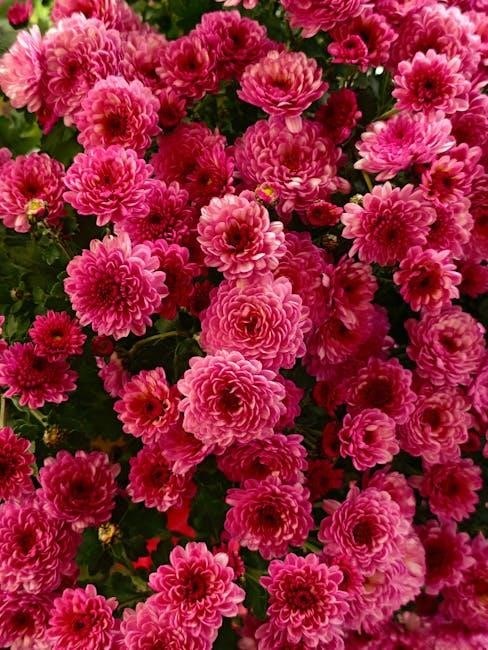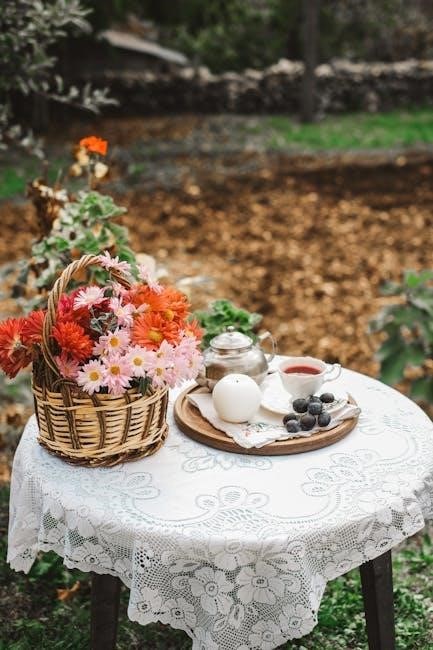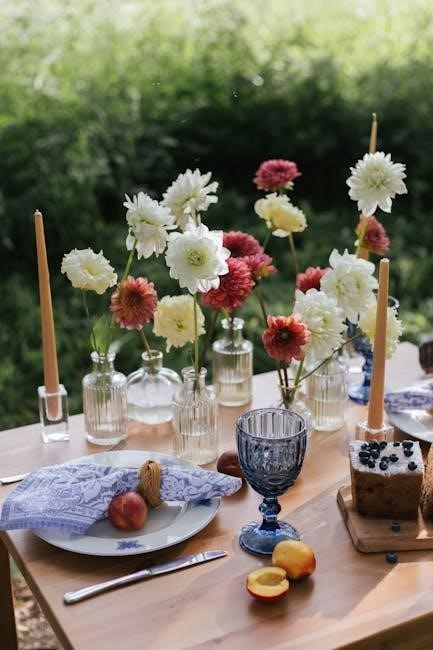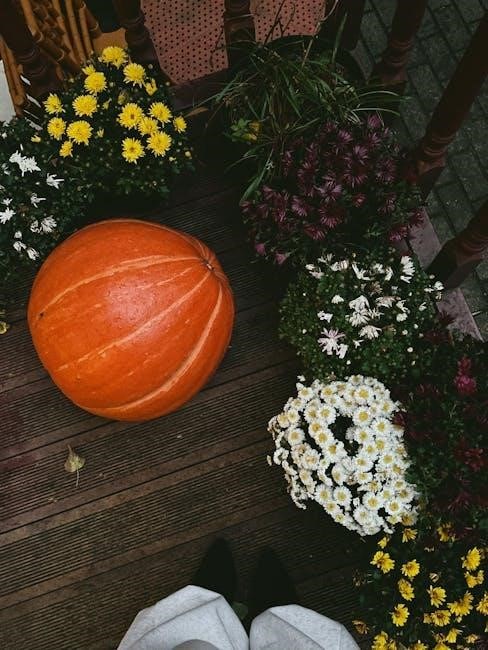John Steinbeck’s The Chrysanthemums is a poignant short story exploring themes of isolation, gender roles, and disillusionment through the life of Elisa Allen in rural California․
1․1 Background of the Story
Set in the Salinas Valley of California during the 1930s, The Chrysanthemums reflects the social and economic realities of the time․ The story is part of Steinbeck’s collection of short stories, The Long Valley, published in 1938․ It captures the isolation and loneliness of rural life, particularly through the protagonist, Elisa Allen․ Steinbeck’s vivid portrayal of the landscape and characters highlights the struggles of farmers and laborers during the Great Depression․ The narrative explores themes of identity, gender roles, and the human desire for connection, all set against the backdrop of a changing agricultural landscape․ The story’s focus on Elisa’s inner world and her fleeting encounter with a stranger underscores Steinbeck’s ability to weave profound emotional depth into a deceptively simple tale․

1․2 Importance of “The Chrysanthemums” in Steinbeck’s Work
John Steinbeck’s The Chrysanthemums holds a significant place in his literary oeuvre, serving as a bridge between his earlier works and the more complex narratives of his later career․ This short story showcases Steinbeck’s ability to craft deeply symbolic and emotionally resonant tales, often focusing on the lives of marginalized individuals․ It highlights his fascination with themes of isolation, gender roles, and the human condition, which are central to many of his works․ The story’s concise yet powerful narrative structure demonstrates Steinbeck’s mastery of the short story form, making it a standout piece in his collection․ Additionally, The Chrysanthemums is often praised for its vivid imagery and psychological depth, cementing its importance in Steinbeck’s body of work and in American literature as a whole․
1․3 Brief Summary of the Plot
Set in the Salinas Valley, the story revolves around Elisa Allen, a skilled gardener, and her husband Henry, living a quiet, isolated life․ Elisa’s passion for chrysanthemums symbolizes her unfulfilled desires and creativity․ One day, a traveling stranger arrives, admiring her flowers and offering to repair pots․ Elisa, feeling understood, shares her passion and gives him some chrysanthemum shoots․ After the stranger leaves, Elisa prepares for a evening out with Henry, but her excitement fades when she discovers the stranger has discarded her flowers․ This moment of betrayal leaves Elisa emotionally drained, highlighting her inner struggle and the reality of her unexpressed dreams․
Themes in “The Chrysanthemums”

The story explores themes of isolation, gender roles, and disillusionment, reflecting Elisa’s struggle with societal expectations and her unfulfilled desires in a patriarchal world․

2․1 The Theme of Isolation
Isolation is a central theme in The Chrysanthemums, as Elisa Allen feels disconnected from the world around her․ Living on a remote ranch, she is physically and emotionally isolated, with limited interaction beyond her husband and occasional strangers․ Her chrysanthemums serve as a symbol of her inner life, which she nurtures in solitude․ Elisa’s isolation is compounded by her husband’s lack of understanding and the societal constraints that confine her to domestic roles․ The story highlights how isolation can lead to a sense of loneliness and unfulfilled potential, as Elisa longs for connection and meaning beyond her isolated existence․ Steinbeck uses her isolation to explore broader themes of loneliness and the human need for connection in a seemingly indifferent world․
2;2 The Role of Gender Roles in the Story
In The Chrysanthemums, Steinbeck explores the restrictive gender roles of the early 20th century, particularly through Elisa Allen’s character․ Elisa is portrayed as a strong, capable woman confined to domestic duties, reflecting the societal expectations placed on women at the time․ Her husband, Henry, embodies traditional patriarchal values, often overlooking her intellectual and emotional needs․ The story highlights the tension between Elisa’s desire for independence and the limitations imposed by her gender․ Steinbeck uses Elisa’s interactions, especially with the stranger, to illustrate her suppressed ambitions and the societal constraints that prevent her from pursuing a more fulfilling life․ This theme underscores the struggles women faced in a male-dominated world, making it a central element of the narrative․
2․3 The Concept of Disillusionment
Disillusionment is a central theme in The Chrysanthemums, as Elisa Allen’s encounter with the stranger shatters her illusions about her life and potential․ Initially, Elisa finds fulfillment in her gardening, symbolizing her desire for creativity and connection․ However, the stranger’s manipulation and subsequent rejection of her chrysanthemums crush her hopes of escaping her mundane existence․ This moment reflects the broader societal disillusionment of the early 20th century, particularly for women, as they faced limited opportunities and societal constraints․ Steinbeck uses Elisa’s emotional journey to highlight the tension between aspiration and reality, leaving her with a profound sense of loss and resignation․ The story underscores how disillusionment can stem from unmet expectations and the harsh realities of one’s circumstances․

Character Analysis
The story revolves around Elisa Allen, her husband Henry, and the mysterious stranger, each representing different facets of human struggle and emotional depth in Steinbeck’s narrative․
3․1 Elisa Allen: The Protagonist
Elisa Allen is the central figure of the story, portrayed as a strong, capable, and passionate woman trapped in a life of quiet desperation․ Her dedication to her chrysanthemum garden symbolizes her deep desire for creativity and fulfillment, which contrasts with the monotony of her daily routine․ Despite her strength, Elisa feels unappreciated and isolated, yearning for connection and recognition․ Her encounter with the stranger awakens her suppressed emotions, revealing a vulnerability beneath her stoic exterior․ Through Elisa, Steinbeck explores themes of femininity, identity, and the constraints placed on women in a patriarchal society․ Her character serves as a powerful representation of unfulfilled potential and the longing for meaningful expression․
3․2 Henry Allen: The Husband
Henry Allen, Elisa’s husband, is a practical and hardworking man who manages the family ranch․ He is kind but emotionally distant, failing to recognize Elisa’s deep need for connection and creative expression․ Henry’s focus on farming and financial success leaves little room for understanding Elisa’s passion for her chrysanthemums, which symbolize her inner world․ His inability to appreciate her talents contributes to her feelings of isolation․ Henry represents the societal norms of his time, viewing women’s roles as secondary to men’s․ While he is not unloving, his lack of emotional engagement exacerbates Elisa’s sense of loneliness and unfulfillment․ Through Henry, Steinbeck critiques the limitations of traditional gender roles and their impact on relationships․
3․3 The Stranger: A Symbolic Figure
The Stranger, a wandering tinker, serves as a pivotal and symbolic figure in Elisa’s life․ His brief interaction with her sparks a moment of connection and hope, as he shows genuine interest in her chrysanthemums, something her husband and others overlook․ The Stranger represents the outside world and the possibilities it holds, offering Elisa a fleeting sense of validation and escape from her isolation․ However, his later rejection of her gift of flowers shatters her illusions, deepening her despair․ Through the Stranger, Steinbeck highlights the fragility of hope and the harsh realities of Elisa’s confined existence․ The Stranger’s role underscores the theme of disillusionment, leaving Elisa more aware of her unfulfilled desires and the limitations of her life․
Setting of the Story
Set in California’s Salinas Valley during the early 20th century, the story’s rural setting mirrors Elisa’s isolation and inner turmoil, emphasizing themes of loneliness and unfulfilled potential․
4․1 The Time Period
The story is set in the early 20th century, during a time of significant social and economic change in America․ The Great Depression looms in the background, casting a shadow over the lives of the characters․ Steinbeck’s portrayal of rural life in California during this era highlights the isolation and hardships faced by farmers and their families․ The time period also reflects the rigid gender roles and societal expectations that trap Elisa Allen in a life she did not choose․ The economic struggles and limited opportunities of the era underscore the themes of disillusionment and unfulfilled potential․ By setting the story in this specific time, Steinbeck critiques the societal norms that confined women and explores the emotional toll of a life unfulfilled․ The historical context adds depth to the narrative, making it a powerful commentary on the human condition during a tumultuous era․
4․2 The Physical Setting and Its Significance
The story is set in the Salinas Valley, a rural area in California, during the early 20th century․ The physical setting plays a crucial role in shaping the narrative and its themes․ Elisa’s garden, filled with chrysanthemums, symbolizes her passion, creativity, and sense of control․ The fence surrounding the garden represents both protection and confinement, mirroring Elisa’s isolated existence․ The vast, open landscape beyond the farm contrasts with the confined spaces of her life, emphasizing her longing for freedom and connection․ The setting also reflects the seasonal cycle, with winter approaching, symbolizing the end of growth and the onset of barrenness, paralleling Elisa’s emotional state․ Steinbeck’s vivid descriptions of the environment create a vivid backdrop for exploring themes of isolation, gender roles, and disillusionment․

Steinbeck’s Writing Style
Steinbeck’s vivid imagery and straightforward narrative style in The Chrysanthemums create a strong sense of place and mood, drawing readers into Elisa’s emotional journey through subtle yet powerful language․
5․1 Narrative Techniques
Steinbeck employs a third-person limited narrative voice in The Chrysanthemums, focusing closely on Elisa Allen’s inner world to evoke empathy and understanding․ His use of descriptive language paints vivid imagery, immersing readers in the setting and Elisa’s emotional state․ The story’s pacing is deliberate, with moments of quiet introspection contrasting with brief, dynamic interactions․ Steinbeck’s dialogue is sparse but meaningful, revealing character traits and underlying tensions․ He also uses symbolism, particularly the chrysanthemums, to convey deeper themes without overt explanation․ The narrative’s subtlety allows readers to interpret Elisa’s unspoken desires and frustrations, enhancing the story’s emotional resonance․ This approach underscores Steinbeck’s mastery of conveying complex human experiences through understated yet powerful storytelling techniques․
5․2 Use of Language and Imagery
Steinbeck’s masterful use of language and imagery in The Chrysanthemums creates a vivid and emotionally resonant narrative․ His descriptive prose paints the Salinas Valley landscape in stark detail, from the “gray-flannel fog” to the “hard, clean ring” of the chrysanthemums․ The imagery of the flowers themselves—vibrant, yet confined—mirrors Elisa’s inner life, symbolizing her suppressed vitality and longing․ Steinbeck employs sensory language to evoke the textures of the natural world, such as the “sodden little river” and the “wet earth,” which contrast with the dry, barrenness of Elisa’s existence․ His imagery also reflects the emotional undertones of scenes, like the “bright, hard” light of the stranger’s arrival, which disrupts the monotony of her life․ Through this rich, evocative language, Steinbeck crafts a story that is both visually striking and deeply symbolic․

Symbolism in “The Chrysanthemums”
6․1 The Chrysanthemums as a Symbol
The chrysanthemums symbolize Elisa’s identity, creativity, and unfulfilled desires, representing her inner world and emotional struggles in a society governed by rigid expectations․
6․2 The Fence: A Barrier or a Protector?
The fence enclosing Elisa’s garden signifies both protection and confinement, mirroring her dual existence of safety and isolation in her controlled yet suffocating environment․
The chrysanthemums in Steinbeck’s story are a powerful symbol of Elisa Allen’s identity, creativity, and unfulfilled desires․ They represent her inner world, reflecting her emotional and psychological state․ The flowers embody her passion, dedication, and nurturing nature, contrasting sharply with the barrenness of her marital life․ Through her meticulous care of the chrysanthemums, Elisa expresses her artistic side, which remains unappreciated by her husband․ The flowers also symbolize her longing for recognition and connection, as well as her isolation from the world beyond her garden․ Their brief encounter with the stranger highlights the transient nature of acknowledgment and the enduring silence of her existence․ Ultimately, the chrysanthemums serve as a metaphor for Elisa’s suppressed potential and the societal constraints that confine her․
The fence in The Chrysanthemums serves as a dual symbol, representing both protection and confinement․ It encloses Elisa’s garden, safeguarding her cherished chrysanthemums from external threats, yet it also isolates her from the outside world․ The fence embodies Elisa’s desire for control and order in her life, as she meticulously tends to her flowers within its boundaries․ However, it also signifies the limitations imposed by her circumstances, trapping her in a life she feels is unfulfilling․ The stranger’s breach of the fence disrupts this carefully maintained space, symbolizing the intrusion of reality into Elisa’s sheltered existence․ Thus, the fence is both a protector of her sanctuary and a barrier that reinforces her emotional and physical isolation․
John Steinbeck’s The Chrysanthemums is a profound exploration of isolation, gender roles, and disillusionment, offering timeless insights into human struggle and emotional depth, resonating universally․
7․1 Summary of Key Points
John Steinbeck’s The Chrysanthemums revolves around Elisa Allen, a woman trapped in a life of isolation and unfulfilled desires․ The story explores themes of gender roles, disillusionment, and the struggle for self-expression․ Set in the Salinas Valley, the narrative highlights Elisa’s emotional journey as she navigates her mundane existence and encounters a mysterious stranger who briefly awakens her hopes․ The chrysanthemums symbolize her identity, creativity, and longing for connection․ Through vivid imagery and a poignant tone, Steinbeck critiques societal constraints and the limitations placed on women․ The story concludes with Elisa’s shattered illusions, leaving her in a state of profound sadness and resignation․ This masterpiece remains a powerful commentary on human isolation and the search for meaning in a restrictive world․
7․2 The Significance of “The Chrysanthemums” in Literature

John Steinbeck’s The Chrysanthemums holds a significant place in American literature for its profound exploration of universal themes such as isolation, gender roles, and disillusionment․ The story’s ability to capture the inner struggles of its protagonist, Elisa Allen, resonates deeply with readers, making it a timeless piece․ Steinbeck’s mastery of narrative techniques and symbolic imagery enhances the emotional depth of the story, allowing it to transcend its regional setting․ The novella’s concise yet powerful structure has made it a staple in academic studies, often analyzed for its feminist undertones and psychological complexity․ Its enduring relevance lies in its ability to reflect the human condition, offering insights into the societal constraints and personal aspirations that shape individual lives․ As such, The Chrysanthemums remains a vital work in understanding Steinbeck’s contribution to 20th-century literature․

